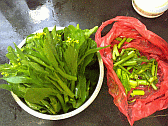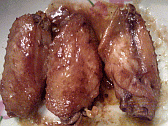|
|
| Chinese
Recipes |
Mooncakes
or Yuuet Beurng |
|
| Mooncakes are a traditional
Chinese delicacy which are generally only available
once a year during Mid-autumn Festival or Zhongqiu Jie.
This celebration is a lunar cycle, and in many ways
very similar to the Western Easter. |
|
Mid-Autumn Festival occurs on the 15th day of
the eighth month of the Chinese calendar, which
is in September or early October in the Gregorian
calendar. It is a date that parallels the autumnal
equinox of the solar calendar, when the moon is
at its fullest and roundest. Please see our page
Mid-autumn Festival for more details.
In UK people always give Easter Eggs to family
and friends, and the giving of Mooncakes is similar
in China, but more widespread and extends to important
friends and business associates in particular.
Face is acquired by giving brands regarded generally
as being 'the best', or by offering specialties.
If you are honest, then Easter Eggs are not dissimilar?
A standard supermarket price would be Y15 RMB
each when sold separately, with boxes containing
4 from Y70 RMB upwards. Often the most prestigious
are sold by notable quality hotels, and people
will travel several hours on a bus to reach the
best outlet - often in another city. Most presentation
boxes will leave you change from Y100, but some
are a lot more expensive!
Mooncakes are generally square although some are
round. They are normally 2.5 inches square by
1.5 inches high, and are customarily cut into
four sections, which are divided between those
present. When serving, cut with the sharpest knife
you have, and re-assemble so they look whole.
Family will often divide one mooncake into a dozen
small pieces, especially if they are a selection
box offering different fillings.
Most are sold in lavish boxes as pictured, each
containing at least 4 mooncakes, eating implements,
and sometimes other treats. I once received a
box containing 10 assorted ones! However, they
are also available individually or in smaller
and obviously cheaper packaging.
Whilst the exterior of all may look remarkably
similar, what is inside varies tremendously! Most
have a filling of fruit jelly or a nut mixture.
Many have an egg in the centre to signify Change
or the Woman of the Moon. Some have meat inside,
and others contain - I have no idea? I seem to
remember that occasionally the best are basted
with dripping, so check with a friend if you have
dietary foibles.
The majority of Chinese people love giving these
boxes as lavish presents, whilst very few actually
enjoy eating the contents.
The best ones echo the taste of genuine British
Bakewell Tarts - these are the original ones bought
from only a couple of small family bakers in the
Derbyshire village of Bakewell - not the mass
produced alternatives.
The egg yoke in the centre is very edible, usually
sweetened and often gelatinised or processed in
some way? The slice pictured right is filled with
a melon or gourd base that is gelatinised and
has the slight taste of almonds. Our comparison
with 'real' Bakewell tarts is quite appropriate
in this respect.
Mid-autumn Festival usually coincides with Chinese
National Golden Week Holidays, which begin each
year on 1st October. When like this year (2010)
the two are a week apart it can lead to some confusion
regards public holidays and time off work, especially
for foreign businessmen. |





|
|
|
If you receive a giftbox of Mooncakes then know you
are being both honoured and included in Chinese tradition.
There is no requirement for foreigners to return a similar
gift to the giver, but it would be wise to do so. This
in turn means that you, your PA, wife or close friends
needs to be aware of your social circle, and of what
to expect - often PA's will exchange notes behind the
scenes so no embarrassment can be inferred.
Brief Information
The Mid-Autumn Festival is one of the few most important
holidays in the Chinese calendar and dates back over
3, 500 years. Farmers celebrate the official end of
summer harvest on this date. Traditionally on this day,
Chinese family members and friends will gather to admire
the bright mid-autumn harvest moon, eat moon cakes and
Chinese grapefruit under the moon together. Accompanying
the celebration are additional cultural or regional
customs, such as:
* Carrying brightly lit lanterns, lighting lanterns
on towers, floating sky lanterns
* Burning incense in reverence to deities such as Chang'e
(Chinese: 嫦娥; pinyin: Cháng'é) - 'The woman in the Moon'.
Related Pages:
* Mid-autumn Festival
* Chang-e
(Chang'e), The Lady of the Moon
* Mooncakes - this page |
|
This information is as supplied by ourselves, and
ably supported by our friends and various internet
portals. |
|
| Search
this Website |
|
|
| Descriptions |









|
| Chinese Recipes |




|
|